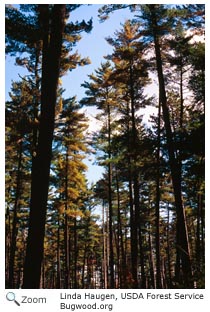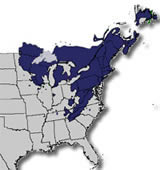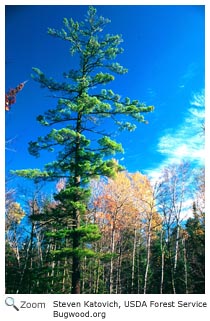Description
 The white pine is the largest conifer in the Northeast. It has a straight trunk with a crown of horizontal branches. It can grow to be 100 feet tall and its trunk can have a diameter of 3-4 feet. It has slender, greenish-blue needles that are 2.5-5 inches long that grow in bundles of five. It has long, narrow yellowish-brown cones 6-8 inches long. The bark of the white pine is smooth and gray when the tree is young. It becomes gray-brown and deeply furrowed as the tree ages. The white pine can live to be 400 years old. The white pine is the largest conifer in the Northeast. It has a straight trunk with a crown of horizontal branches. It can grow to be 100 feet tall and its trunk can have a diameter of 3-4 feet. It has slender, greenish-blue needles that are 2.5-5 inches long that grow in bundles of five. It has long, narrow yellowish-brown cones 6-8 inches long. The bark of the white pine is smooth and gray when the tree is young. It becomes gray-brown and deeply furrowed as the tree ages. The white pine can live to be 400 years old.
Habitat
The white pine grows in most soils in its range, but it grows best in well-drained sandy soil.
Range  The white pine is found from southeast Manitoba east to Newfoundland, Canada and south to northern Georgia, and west to northeast Iowa. It is found from sea level to 2,000 feet. In the Southern Appalachia Mountains, it is found as high as 5,000 feet. The white pine is found from southeast Manitoba east to Newfoundland, Canada and south to northern Georgia, and west to northeast Iowa. It is found from sea level to 2,000 feet. In the Southern Appalachia Mountains, it is found as high as 5,000 feet.
| | | |
Reproduction
 Both male and female flowers or strobili are on the same tree. In the spring, pollen on the staminate or male cones pollinate the female or pistillate cones. The wind often helps move pollen from the male to the female cones! Both male and female flowers or strobili are on the same tree. In the spring, pollen on the staminate or male cones pollinate the female or pistillate cones. The wind often helps move pollen from the male to the female cones!
Uses
 The white pine tree was once the most valuable tree in the Northeast because of the role it played in the mast trade. The tall, straight trees were perfect for ship masts and spars! During the Colonial period, the best white pines were reserved for use by the British Royal Navy. This didn't go over very well with the colonists, in fact there was even a Pine Tree Riot in Weare, N.H. over the British use of the white pine tree! The pine tree even became a New England symbol of liberty, freedom, independence, and strength and its image appeared on many flags, banners, coins, and pamphlets. The white pine tree was once the most valuable tree in the Northeast because of the role it played in the mast trade. The tall, straight trees were perfect for ship masts and spars! During the Colonial period, the best white pines were reserved for use by the British Royal Navy. This didn't go over very well with the colonists, in fact there was even a Pine Tree Riot in Weare, N.H. over the British use of the white pine tree! The pine tree even became a New England symbol of liberty, freedom, independence, and strength and its image appeared on many flags, banners, coins, and pamphlets.
Logging has destroyed most of the original white pine forests, but the species is aggressive in reproducing itself and is found throughout its original range. The white pine is also grown on tree farms and plantations. The tree has a soft wood and is often used for pulp and to make furniture, crates, paneling, match sticks, and boats. White pine is also cultivated for Christmas trees.
|